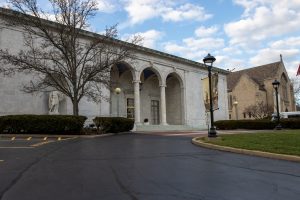By Emily McCarthy

With new safety protocols and Gov. Mike DeWine’s new guidelines, art museums near campus have faced major changes when reopening this fall. New practices, event alternatives, reduced occupancy and reduced hours have been implemented.
Wendy Swick is the public relations director at Butler Institute of American Art. She said there are many new changes when entering the building. Everyone is required to take their temperature, wear a mask, follow directional arrows on the floor and follow maximum capacity guidelines in each gallery.
Some more unique changes have taken place as well.
“We actually made a change to our air handling system, which makes sure that fresh air is coming in and it’s not recycling old air,” she said. “Our museum store, we are planning for that to open back up, but it’s a small space so that’s a challenge there to make it shoppable. We added [Plexiglas] at the desks. At the museum store, there will be [Plexiglas] between the cashier and customers.”
Swick said school tours have been a big challenge for them. Since large gatherings are now prohibited, they needed funding for alternative educational outreach.
“[We] have put together an educational program and it’s being video recorded, and that will be the continuation of our Good Neighbors outreach program,” she said. “Libraries will be able to use those educational videos.”
Claudia Berlinski, director of McDonough Museum of Art, said while a lot of the safety protocols for the museum is set up to look like most of the classes on campus, with QR codes and hand-washing stations, there have been some unique changes as well.
“We typically would have two student employees working at a time, but right now we’ve limited it to one, and we have them separated away from the entry so they are six feet away from whoever might come in,” she said. “We are trying to reach out to the community virtually just so we stay on their minds so they don’t forget about us or think we are not open.”
One way the museum is doing this, Berlinski said, is by holding small recording sessions with small groups and solo performers. Those videos are then uploaded to YouTube to substitute live events.
The transition is not without challenges. Berlinski said after last semester’s virtual exhibition for graduating art students, she is working on a way to get them to be able to do their senior projects back in the museum.
“Last semester, we had to close up the building at the end of March, and so our Bachelor of Fine Arts students couldn’t do their exhibition in the museum as they normally would. This semester, we actually are going to have the BFA Exhibition, but again, we can’t have an opening,” she said. “Those are typically very large openings. I am trying to work out some details so we can have a staggered entry.”
It has also been hard to find new artists to fill slots, Berlinski said.
“We were going to have some poetry readings this semester and they felt like they didn’t want to do a virtual poetry reading because it is not the same without an audience,” she said. “We have had some postponements of shows by artists because they would … have to travel from a distance to do an installation … and in one case I know, at least, the person has health issues.”
Jessica Trickett, collections manager of the Arms Family Museum, said one major difference is the museum’s limited hours. After reopening in August, instead of being open Tuesday through Sunday, they limited their days to Friday through Sunday.
Masks are also provided upon entry for anyone who may have forgotten theirs, and sanitation stations have been placed at several locations.
“It’s been a very slow start to come back in … we are doing a lot more cleaning at our sites,” she said. “After our guests come, we do wipe down our handrails and other access points, restrooms.”
With many of the exhibits including fragile antique items that are not easily cleaned, staff members in some cases wear gloves to touch certain items. Although the museum is “no touch,” Trickett said if something were accidentally touched, the item would likely be quarantined or covered.
Some of the most popular yearly events have been changed.
“We have had to cancel our Memories of Christmas Past exhibit for this year and we are doing some alternative programs both online and at our Tyler History Center site … where we can spread out a little bit more,” she said. “We have a ballroom there. We are going to do a pop-up christmas gift shop and then a smaller scale history exhibit of our holiday collections down there as well.”
